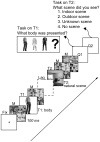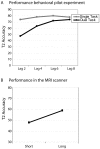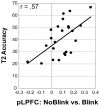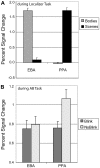Neural competition for conscious representation across time: an fMRI study
- PMID: 20479939
- PMCID: PMC2866664
- DOI: 10.1371/journal.pone.0010556
Neural competition for conscious representation across time: an fMRI study
Abstract
Background: The information processing capacity of the human mind is limited, as is evidenced by the attentional blink (AB)--a deficit in identifying the second of two temporally-close targets (T1 and T2) embedded in a rapid stream of distracters. Theories of the AB generally agree that it results from competition between stimuli for conscious representation. However, they disagree in the specific mechanisms, in particular about how attentional processing of T1 determines the AB to T2.
Methodology/principal findings: The present study used the high spatial resolution of functional magnetic resonance imaging (fMRI) to examine the neural mechanisms underlying the AB. Our research approach was to design T1 and T2 stimuli that activate distinguishable brain areas involved in visual categorization and representation. ROI and functional connectivity analyses were then used to examine how attentional processing of T1, as indexed by activity in the T1 representation area, affected T2 processing. Our main finding was that attentional processing of T1 at the level of the visual cortex predicted T2 detection rates Those individuals who activated the T1 encoding area more strongly in blink versus no-blink trials generally detected T2 on a lower percentage of trials. The coupling of activity between T1 and T2 representation areas did not vary as a function of conscious T2 perception.
Conclusions/significance: These data are consistent with the notion that the AB is related to attentional demands of T1 for selection, and indicate that these demands are reflected at the level of visual cortex. They also highlight the importance of individual differences in attentional settings in explaining AB task performance.
Conflict of interest statement
Figures






Similar articles
-
Contributions of the Ventral Striatum to Conscious Perception: An Intracranial EEG Study of the Attentional Blink.J Neurosci. 2017 Feb 1;37(5):1081-1089. doi: 10.1523/JNEUROSCI.2282-16.2016. Epub 2016 Dec 16. J Neurosci. 2017. PMID: 27986925 Free PMC article.
-
No evidence for early modulation of evoked responses in primary visual cortex to irrelevant probe stimuli presented during the attentional blink.PLoS One. 2011;6(8):e24255. doi: 10.1371/journal.pone.0024255. Epub 2011 Aug 25. PLoS One. 2011. PMID: 21901165 Free PMC article. Clinical Trial.
-
Representational dynamics preceding conscious access.Neuroimage. 2021 Apr 15;230:117789. doi: 10.1016/j.neuroimage.2021.117789. Epub 2021 Jan 23. Neuroimage. 2021. PMID: 33497774
-
The interplay of attention and consciousness in visual search, attentional blink and working memory consolidation.Philos Trans R Soc Lond B Biol Sci. 2014 Mar 17;369(1641):20130215. doi: 10.1098/rstb.2013.0215. Print 2014 May 5. Philos Trans R Soc Lond B Biol Sci. 2014. PMID: 24639586 Free PMC article. Review.
-
The attentional blink: a review of data and theory.Atten Percept Psychophys. 2009 Nov;71(8):1683-700. doi: 10.3758/APP.71.8.1683. Atten Percept Psychophys. 2009. PMID: 19933555 Free PMC article. Review.
Cited by
-
Isolating a cerebellar contribution to rapid visual attention using transcranial magnetic stimulation.Front Behav Neurosci. 2012 Aug 24;6:55. doi: 10.3389/fnbeh.2012.00055. eCollection 2012. Front Behav Neurosci. 2012. PMID: 22936903 Free PMC article.
-
Access to consciousness of briefly presented visual events is modulated by transcranial direct current stimulation of left dorsolateral prefrontal cortex.Sci Rep. 2019 Jul 29;9(1):10950. doi: 10.1038/s41598-019-47527-4. Sci Rep. 2019. PMID: 31358875 Free PMC article.
-
The N400 component reflecting semantic and repetition priming of visual scenes is suppressed during the attentional blink.Atten Percept Psychophys. 2025 May;87(4):1199-1218. doi: 10.3758/s13414-024-02997-1. Epub 2024 Dec 24. Atten Percept Psychophys. 2025. PMID: 39719536 Free PMC article.
-
Time to see the bigger picture: Individual differences in the attentional blink.Psychon Bull Rev. 2016 Oct;23(5):1289-1299. doi: 10.3758/s13423-015-0977-2. Psychon Bull Rev. 2016. PMID: 26576803 Free PMC article. Review.
-
Musical minds: attentional blink reveals modality-specific restrictions.PLoS One. 2015 Feb 25;10(2):e0118294. doi: 10.1371/journal.pone.0118294. eCollection 2015. PLoS One. 2015. PMID: 25714836 Free PMC article.
References
-
- Desimone R, Duncan J. Neural mechanisms of selective visual attention. Annual Rev Neurosci1. 2005;8:193–222. - PubMed
-
- Lamme VA, Roelfsema PR. The distinct modes of vision offered by feedforward and recurrent processing. Trends Neurosci. 2000;23(11):571–579. - PubMed
-
- Miller EK, Cohen JD. An integrative theory of prefrontal cortex function. Annual Rev Neurosci. 2001;24:167–202. - PubMed
-
- Kastner S, Underleider L. The neural basis of biased competition in human visual cortex. Neuropsychologia. 2001;39(12):1263–1276. - PubMed
-
- Raymond JE, Shapiro KL, Arnell KM. Temporary suppression of visual processing in an RSVP task: An attentional blink? J Exp Psychol Hum Percept Perform. 1992;18:849–860. - PubMed
Publication types
MeSH terms
Grants and funding
LinkOut - more resources
Full Text Sources
Medical

